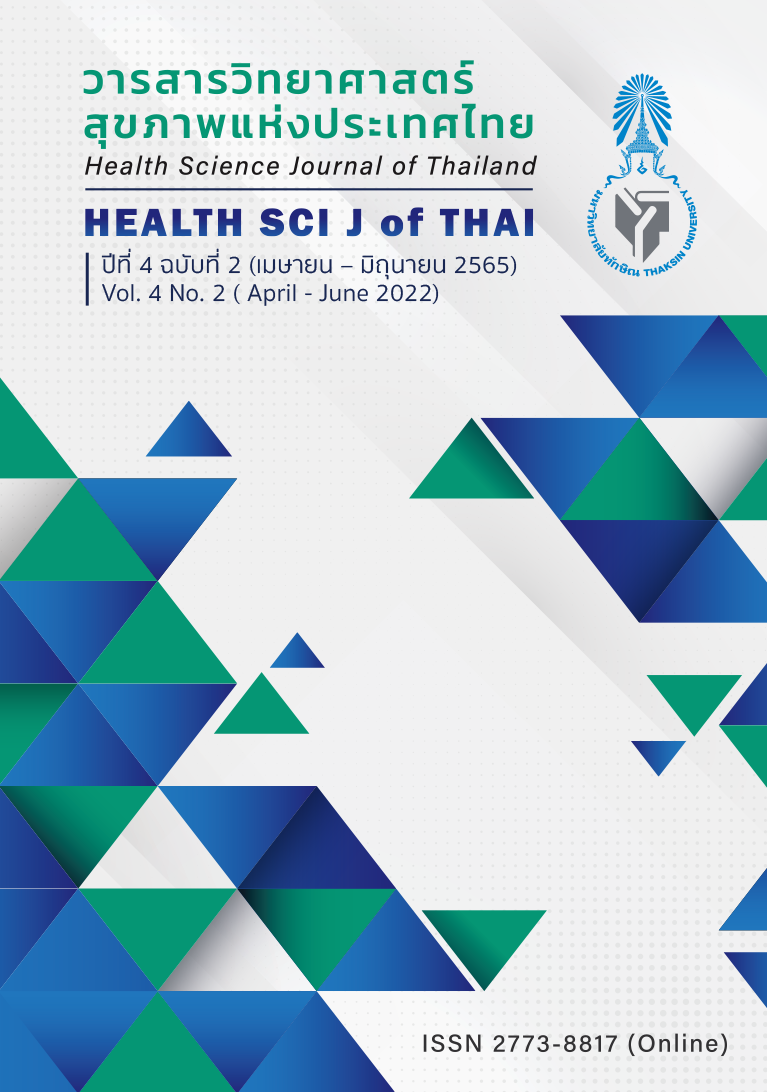The Effects of Self Efficacy Promoting “3D” Program on Phosphate Control Behaviors and Serum Phosphate Level in Patients Receiving Hemodialysis: A Feasibility Study
Main Article Content
Abstract
Hyperphosphatemia causes a high mortality rate in patients receiving hemodialysis (HD); as a result, the proper behaviors for controlling serum phosphate are crucial. This study is quasi-experimental research, one-group time-series design, aimed to evaluate the effects of Self-efficacy Promoting 3D Program on phosphate control behaviors, and serum phosphate level in patients with end-stage renal disease receiving hemodialysis. The 22 participants were purposely recruited. The research instruments were Self-efficacy Promoting 3D Program, which lasted for 16 weeks. The research instruments for collecting data were questionnaires: knowledge of phosphate control, perceived self-efficacy, phosphate control behaviors, and serum phosphate level. Descriptive statistics, Friedman test, and Wilcoxon signed-rank test were used to analyze the data. The results revealed participants’ scores of knowledge of phosphate control, perceived self-efficacy in controlling serum phosphate, phosphate control behaviors were significant statistically increased (p <0.050) after 16 weeks of the program. Moreover, serum phosphate was decreased significantly (p <0.050) at the end of the program. It indicated that the program enhanced positive clinical outcomes. Nurses should apply this program to patients with hyperphosphatemia in the hemodialysis unit. The results revealed participants’ scores of knowledge of phosphate control, perceived self-efficacy in controlling serum phosphate, phosphate control behaviors were increased statistically significant (p < .05) after 16 weeks of the program. Moreover, serum phosphate was decreased significantly (p < .05) at the end of the program. This program demonstrated the positive effects of health outcomes and serum phosphate. Consequently, hemodialysis nurses should apply this program to the hemodialysis unit for ESRD patients with hyperphosphatemia.
Article Details

This work is licensed under a Creative Commons Attribution-NonCommercial-NoDerivatives 4.0 International License.
References
The Nephrology Society of Thailand. Hemodialysis Clinical Practice Recommendation 2014. Bangkok: Nephrology Society of Thailand; 2014. (in Thai)
The Nephrology Society of Thailand. Thailand renal replacement therapy registry report 2017. Chuasuwan A, Praditpornsilpa K, editors Bangkok: Nephrology Society of Thailand; 2017.
Kidney Disease Improving Global Outcomes CKD-MBD Work Group. KDIGO clinical practice guideline for the diagnosis, evaluation, prevention, and treatment of chronic kidney disease-mineral and bone disorder (CKD-MBD). Kidney Int Suppl. 2009; (113): S1-130.
Fernández-Martín JL, Dusso A, Martínez-Camblor P, Dionisi MP, Floege J, Ketteler M, London G, Locatelli F, Górriz JL, Rutkowski B, Bos WJ. Serum phosphate optimal timing and range associated with patients’ survival in haemodialysis: the COSMOS study. Nephrol Dial Transplant 2019; 34(4): 673-681.
Shaman AM, Kowalski SR. Hyperphosphatemia management in patients with chronic kidney disease. Saudi Pharm J. 2016; 24(4): 494-505.
Rastogi A, Bhatt N, Rossetti S, Beto J. Management of Hyperphosphatemia in End-Stage Renal Disease: A New Paradigm. J Ren Nutr 2021; 31(1): 21-34.
Jintana P, Sriyuktasuth A, Pongthavornkamol K, Nata N. Information-motivationbehavioral skills program improved phosphate binder adherence in patients with chronic hemodialysis. J Nurs Sci 2016; 34(2): 92-101. (in Thai).
Sandlin K, Bennett PN, Ockerby C, Corradini AM. The impact of nurse-led education on haemodialysis patients’ phosphate binder medication adherence. J Ren Care 2013; 39(1): 12-18.
Hjemås BJ, Bøvre K, Mathiesen L, Lindstrøm JC, Bjerknes K. Interventional study to improve adherence to phosphate binder treatment in dialysis patients. BMC Nephrol 2019; 20(1): 178.
Cheng TY, Tarng DC, Liao YM, Lin PC. Effects of systematic nursing instruction on a low‐phosphorus diet, serum phosphorus level and pruritus of patients on haemodialysis. J Clin Nurs 2017; 26(3-4): 485-494.
Shi YX, Fan XY, Han HJ, Wu QX, Di HJ, Hou YH, et al. Effectiveness of a nurse-led intensive educational program on chronic kidney failure patients with hyperphosphatemia: randomized controlled trial. J Clin Nurs 2013; 22(7–8):1189–1197.
Milazi M, Douglas C, Bonner A. A bundled phosphate control intervention (4Ds) for adults with end‐stage kidney disease receiving haemodialysis: A cluster randomized controlled trial. J Adv Nurs 2021; 77(3): 1345-1356.
Milazi M, Bonner A, Douglas C. Effectiveness of educational or behavioral interventions on adherence to phosphate control in adults receiving hemodialysis: a systematic review. JBI Evid Synth 2017; 15(4): 971-1010.
Wongsaree C, Praneetham W. The study of relationship and factors influencing of dietary and fluid consumption among end stage renal disease patient receiving hemodialysis. J Royal Thai Army Nurses 2018; 19(3): 117-125. (in Thai).
Isaacs B, Kennie AT. The Set test as an aid to the detection of dementia in old people. Br J Psychiatry 1973; 123(575): 467-470.
Bandura A. Self-efficacy: toward a unifying theory of behavioral change. Psychol Rev 1977; 84(2): 191.
Suwanpairat J. Factors influencing serum phosphate control behaviors in hemodialysis patients. [Master’s Thesis]. Nakhon Pathom: Mahidol University; 2012. (in Thai)


